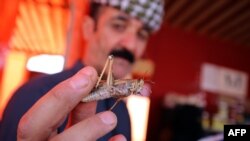As African regions head into the warmer months, nymph locusts are growing their wings and migrating to Saudi Arabia, says the head of Iran’s Agricultural Jihad Ministry’s department of plant protection.
"Sadly, the locust problem in Saudi Arabia has not been addressed fundamentally, and therefore a high volume of swarms of locusts have migrated to Iran in search of food," Hamid Dolati said.
Rafsanjan MP Ahmad Mohammadi Anaraki, said on April 22, however, that the attacking swarms will leave the country in May, but if they lay eggs before leaving, Iran will replace the Arabian peninsula as the hub of voracious desert locusts.
On the same day, the head of the Iranian Plant Protection Organization (IPPO) also announced that the agricultural jihad minister had asked the interior ministry to call the governors of six southern provinces to establish a crisis headquarters exclusively for fighting the invasive locusts.
According to the agricultural ministry’s website, Mohammad Reza Dargahi said the desert locusts have severely contaminated the provinces of Bushehr, Fars, Hormozgan, Khuzestan, and Sistan and Baluchestan, as well as southern parts of Iran's largest province, Kerman.
Calling the desert locusts’ attacks on Iran since February "unprecedented," Dargahi accused the Persian Gulf littoral states of being languid in fighting the rapacious insects.
Earlier on April 18, IPPO had warned that if the necessary budget for fighting desert locusts is not provided within two weeks, a locust breakout would inevitably turn into a new crisis alongside floods.
Dargahi said 200,000 hectares of agricultural land in Iran could be devastated by the locusts. "Only 40,000 hectares of farmland in six southern provinces of Iran has so far been prepared for fighting the attacking swarms of desert locusts," he said.
He cautioned that a failure to control the locusts would jeopardize 1,250 trillion rials (approximately $30 billion based on official exchange rate) worth of agricultural products.






